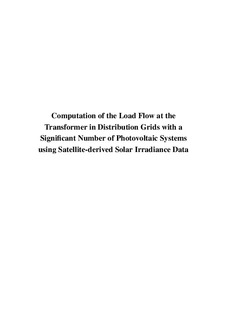| dc.contributor.author | Ruf, Holger Ingmar | |
| dc.date.accessioned | 2016-08-09T07:45:07Z | |
| dc.date.available | 2016-08-09T07:45:07Z | |
| dc.date.issued | 2016 | |
| dc.identifier.isbn | 978-82-7117-827-7 | |
| dc.identifier.issn | 1504-9272 | |
| dc.identifier.uri | http://hdl.handle.net/11250/2398250 | |
| dc.description | Doktorgradsavhandling i fornybar energi, Fakultet for teknologi og realfag, Universitetet i Agder 2016 | nb_NO |
| dc.description.abstract | This thesis investigates the applicability of irradiance data provided by a weather
satellite for the simulation of the high-resolution electric power load flow time series
at a distribution grid transformer in an area with a significant number of residential
PV systems. Up to the present, the feed-in tariff for renewable generators
in Germany has encouraged the installation of a significant number of photovoltaic
systems especially at the low voltage level. Current studies assume a further increase
in the number of systems worldwide. The responsibility for the electric grid
at this voltage level rests on the distribution system operators. However, the photovoltaic
systems affect the characteristics of the electric grid and the distribution
system operator needs more information than the current annual energy measurements
can provide. One option that may contribute to the closing of information
gap is the use of irradiance data derived from remote sensing technologies.
The load flow of the distribution grid transformer at a specific test site in Ulm,
Germany, is calculated as a time series of 15-minute average values for a year.
The feed-in power of each photovoltaic system connected to the grid is calculated
using satellite-derived irradiance data and empirical non-linear photovoltaic models.
The irradiance data are provided by different sources to investigate the influence
of the irradiance source. The feed-in power is calculated with an average bias of
0.04 kW/kWp independent of the rated power of the photovoltaic system and varies
with both the calculation algorithms and photovoltaic system orientation data used.
The consumption time series is modelled with three different load profile types and scaled to the annual energy consumption provided by the distribution system
operator. The different results of the variations are compared based on statistical
measures and threshold detections are expressed as scores.
The bias of the satellite derived irradiance of around 5% affects the simulation
of the feed-in power. Experiment show that feed-in energy is overestimated by 22%
when using satellite irradiance while the use of locally ground-measured irradiance
only results in an overestimation of 3%. However, the statistical description of the
consumption time series based on annual values leads to an additional bias of at least
33% for the energy at the transformer level. These overestimations are also visible
in the scores of threshold detection at both photovoltaic system and transformer levels.
The accuracy of detecting feed-in power above 70% of the photovoltaic system
rating depends on the irradiance data and the modelling of the systems. The average
false alarm rate is above 52% for the investigated test site. The detection of reversal
load flows at the low voltage transformer is overestimated leading to a false alarm
rate of at least 12% of all 15 minutes averages when the sun is higher than 15◦. This work makes clear that the detection accuracy strongly depends on the accuracy
of the input data. The validation of the simulation up-scaled to the medium voltage
level shows the weakness of absolute-value only measurements at the substation.
The simulations also shows reversal load flows at this level. However, these results
cannot be validated due to the limitation of the measurements to absolute values.
To conclude, the simulation of the feed-in power as well as the load flow at
the transformer is overestimated at a local level such as a residential area. The
main errors are caused by the load profile used followed by the satellite-derived
irradiance. An accurate detection of events exceeding a threshold requires accurate
input and model data. Overall the method is able to simulate the load flow at low
voltage and medium voltage levels.
The effects of a significant number of PV systems on the electric grid and load
flows have to be considered in grid planning and grid operations. Satellite-based
irradiance data provides an opportunity to achieve independence from ground-based
measurements limited to one location. If available, the orientation angles should be
taken into account for analysis and calculations at the low voltage level. | nb_NO |
| dc.language.iso | eng | nb_NO |
| dc.publisher | Universitet i Agder / University of Agder | nb_NO |
| dc.relation.ispartofseries | Doctoral dissertations at University of Agder; | |
| dc.relation.ispartofseries | ;134 | |
| dc.rights | CC0 1.0 Universal | * |
| dc.rights.uri | http://creativecommons.org/publicdomain/zero/1.0/ | * |
| dc.title | Computation of the Load Flow at the Transformer in Distribution Grids with a Significant Number of Photovoltaic Systems using Satellite-derived Solar Irradiance Data | nb_NO |
| dc.type | Doctoral thesis | nb_NO |
| dc.subject.nsi | VDP::Technology: 500 | nb_NO |
| dc.source.pagenumber | XX, 155 s. | nb_NO |

